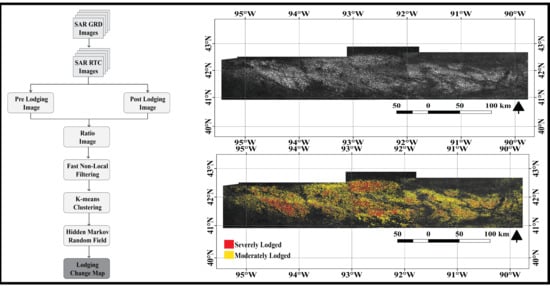Landscape-Scale Crop Lodging Assessment across Iowa and Illinois Using Synthetic Aperture Radar (SAR) Images
Abstract
1. Introduction
- (1)
- Understand the changes in backscatter over large-scale lodged fields and how to use the backscatter to classify lodging into severe or moderate categories.
- (2)
- Generate large-scale spatial extent maps of lodging using a change detection approach modified from our previous study [17] and determine the lodging rate (lodged crop per unit area) using the USDA’s Crop Data Layer (CDL) map.
- (3)
- Qualitatively explore the relationship between high wind speed and lodged fields.
- (4)
- Explore the capability of Sentinel-1A over an optical dataset like the one from Landsat-8.
- (5)
- Explore if lodged and un-lodged (healthy) fields differ between the pre-lodging event image and post-lodging event image.
2. Study Area and Data
2.1. Study Area
2.2. Field Data
2.3. Remote Sensing Data
3. Methods
3.1. Image Preprocessing
3.2. Logarithmic Scaling and Ratio Image Formation
3.3. Change Detection Classification Approach
4. Results
4.1. Sentinel-1A Backscatter Analysis for Lodging Detection
4.2. Qualitative Relationship between High Wind Speed and Lodged Fields
4.3. Reliability of the Approach Employed in Mapping Lodging
5. Discussion
5.1. Spatial-Extent of Lodging and Lodging Rate
- (a)
- Corn acres impacted: ~2.36 million acres impacted out of ~4.90 million acres planted (48% acre impact).
- (b)
- Corn bushels impacted: ~442.37 million bushels impacted out of ~918.36 million bushels expected prior to the storm (48% reduction).
- (c)
- Soybean acres impacted: ~1.27 million acres impacted out of ~4.69 million acres planted (28% acre impact).
- (d)
- Soybean bushels impacted: ~80.90 million bushels impacted out of ~279.00 million bushels expected prior to the storm (29% yield reduction)
5.2. Temporal Behavior of Un-Lodged (Healthy) and Lodged Fields throughout the Observation Period
6. Conclusions
- (1)
- The modified change detection approach used was shown to be capable of providing near real-time monitoring of the Derecho lodging disaster by generating detailed parameters, such as backscatter changes, lodging extent, and lodging rate in corn and soybean. The generated lodging extent maps from SAR showed both severely and moderately damaged fields. The use of CDL also allowed the estimation of lodged crop per unit area, showing relatively more lodging in corn fields than soybean fields. We believe the sensitivity of corn to lodging was caused by its unique structural characteristics (long vertical orientation of its stalk). We estimated that a total of approximately 2.56 million acres of corn and approximately 1.27 million acres of soybean were impacted during the Derecho lodging disaster.
- (2)
- The modified change detection approach used was reliable and the reliability can be seen by the similar distribution patterns of lodged fields in the Sentinel-1A imagery and Landsat-8 imagery. Furthermore, the generated lodged field maps show correlation with areas of extreme wind speed.
- (3)
- The backscatter difference between the timeseries of lodged and un-lodged (healthy) fields differ. Our analyses from nine fields showed almost no change between the pre-lodging event image and post-lodging event image of an un-lodged field while we noted an approximately 6 dB increase in the VH mean polarization backscatter and 5 dB increase in the VV mean polarization backscatter for all the fields between the pre-lodging event date and the post-lodging event date. When we aggregated all the un-lodged fields and the lodged fields across Dallas county, we saw an increase of approximately 3 dB in the VH mean polarization backscatter and 1 dB in the VV mean polarization backscatter between the pre-lodging event date and the post-lodging event date. Taken together, these results suggest that differences in VH polarization and VV polarization can serve as useful lodging indicators at parcel- and landscape-level and enable rapid mapping of widespread lodging events using SAR data.
Author Contributions
Funding
Conflicts of Interest
References
- Pinthus, M.J. Lodging in wheat, barley, and oats: The phenomenon, its causes, and preventive measures. In Advances in Agronomy; Elsevier: Amsterdam, The Netherlands, 1974; Volume 25, pp. 209–263. [Google Scholar]
- Wu, W.; Ma, B.L. A new method for assessing plant lodging and the impact of management options on lodging in canola crop production. Sci. Rep. 2016, 6, 31890. [Google Scholar] [CrossRef] [PubMed]
- Xue, J.; Gou, L.; Zhao, Y.; Yao, M.; Yao, H.; Tian, J.; Zhang, W. Effects of light intensity within the canopy on maize lodging. Field Crop. Res. 2016, 188, 133–141. [Google Scholar] [CrossRef]
- Nielsen, B.; Colville, D. Stalk Lodging in corn: Guidelines for Preventive Management. Available online: https://www.extension.purdue.edu/extmedia/ay/ay-262.html (accessed on 30 October 2020).
- Kong, E.; Liu, D.; Guo, X.; Yang, W.; Sun, J.; Li, X.; Zhan, K.; Cui, D.; Lin, J.; Zhang, A. Anatomical and chemical characteristics associated with lodging resistance in wheat. Crop J. 2013, 1, 43–49. [Google Scholar] [CrossRef]
- Chauhan, S.; Darvishzadeh, R.; Boschetti, M.; Pepe, M.; Nelson, A. Remote sensing-based crop lodging assessment: Current status and perspectives. Isprs J. Photogramm. Remote Sens. 2019, 151, 124–140. [Google Scholar] [CrossRef]
- Shah, S.; Chang, X.; Martin, P. Effect of dose and timing of application of different plant growth regulators on lodging and grain yield of a scottish landrace of barley (bere) in orkney, scotland. Int. J. Environ. Agric. Biotechnol. 2017, 2, 238871. [Google Scholar] [CrossRef]
- Chauhan, S.; Darvishzadeh, R.; Lu, Y.; Boschetti, M.; Nelson, A. Understanding wheat lodging using multi-temporal sentinel-1 and sentinel-2 data. Remote Sens. Environ. 2020, 243, 111804. [Google Scholar] [CrossRef]
- Chauhan, S.; Darvishzadeh, R.; Lu, Y.; Stroppiana, D.; Boschetti, M.; Pepe, M.; Nelson, A. Wheat lodging assessment using multispectral uav data. Int. Arch. Photogramm. Remote Sens. Spat. Inf. Sci. 2019, 235–240. [Google Scholar] [CrossRef]
- Han, D.; Yang, H.; Yang, G.; Qiu, C. 2017 SAR in Big Data Era: Models, Methods and Applications (BIGSARDATA). In Monitoring Model of Corn Lodging Based on Sentinel-1 Radar Image; IEEE: New York, NY, USA, 2017; pp. 1–5. [Google Scholar]
- Zhao, L.; Yang, J.; Li, P.; Shi, L.; Zhang, L. Characterizing lodging damage in wheat and canola using radarsat-2 polarimetric sar data. Remote Sens. Lett. 2017, 8, 667–675. [Google Scholar] [CrossRef]
- Meyer, F.; McAlpin, D.; Gong, W.; Ajadi, O.; Arko, S.; Webley, P.; Dehn, J. Integrating sar and derived products into operational volcano monitoring and decision support systems. Isprs J. Photogramm. Remote Sens. 2015, 100, 106–117. [Google Scholar] [CrossRef]
- Shu, M.; Zhou, L.; Gu, X.; Ma, Y.; Sun, Q.; Yang, G.; Zhou, C. Monitoring of maize lodging using multi-temporal sentinel-1 sar data. Adv. Space Res. 2020, 65, 470–480. [Google Scholar] [CrossRef]
- Chauhan, S.; Darvishzadeh, R.; Boschetti, M.; Nelson, A. Estimation of crop angle of inclination for lodged wheat using multi-sensor sar data. Remote Sens. Environ. 2020, 236, 111488. [Google Scholar] [CrossRef]
- Yang, H.; Chen, E.; Li, Z.; Zhao, C.; Yang, G.; Pignatti, S.; Casa, R.; Zhao, L. Wheat lodging monitoring using polarimetric index from radarsat-2 data. Int. J. Appl. Earth Obs. Geoinf. 2015, 34, 157–166. [Google Scholar] [CrossRef]
- Chen, J.; Li, H.; Han, Y. Fifth International Conference on Agro-Geoinformatics (Agro-Geoinformatics). In Potential of Radarsat-2 Data on Identifying Sugarcane Lodging Caused by Typhoon; IEEE: New York, NY, USA, 2016; pp. 1–6. [Google Scholar]
- Ajadi, O.A.; Meyer, F.J.; Webley, P.W. Change detection in synthetic aperture radar images using a multiscale-driven approach. Remote Sens. 2016, 8, 482. [Google Scholar] [CrossRef]
- Baier, G.; Rossi, C.; Lachaise, M.; Zhu, X.X.; Bamler, R. A nonlocal insar filter for high-resolution dem generation from tandem-x interferograms. IEEE Trans. Geosci. Remote Sens. 2018, 56, 6469–6483. [Google Scholar] [CrossRef]
- Deledalle, C.-A.; Denis, L.; Tupin, F.; Reigber, A.; Jäger, M. Nl-sar: A unified nonlocal framework for resolution-preserving (pol)(in) sar denoising. IEEE Trans. Geosci. Remote Sens. 2014, 53, 2021–2038. [Google Scholar] [CrossRef]
- Kasetkasem, T.; Varshney, P.K. An image change detection algorithm based on markov random field models. IEEE Trans. Geosci. Remote Sens. 2002, 40, 1815–1823. [Google Scholar] [CrossRef]
- Zhao, Q.-H.; Li, X.-L.; Li, Y.; Zhao, X.-M. A fuzzy clustering image segmentation algorithm based on hidden markov random field models and voronoi tessellation. Pattern Recognit. Lett. 2017, 85, 49–55. [Google Scholar] [CrossRef]
- Yang, M.; Yi, C. A novel method of ship detection in high-resolution sar images based on gan and hmrf models. Prog. Electromagn. Res. 2019, 83, 77–82. [Google Scholar] [CrossRef]
- Boryan, C.; Yang, Z.; Mueller, R.; Craig, M. Monitoring us agriculture: The us department of agriculture, national agricultural statistics service, cropland data layer program. Geocarto Int. 2011, 26, 341–358. [Google Scholar] [CrossRef]
- Zhang, Y.; Brady, M.; Smith, S. Segmentation of brain mr images through a hidden markov random field model and the expectation-maximization algorithm. IEEE Trans. Med Imaging 2001, 20, 45–57. [Google Scholar] [CrossRef] [PubMed]
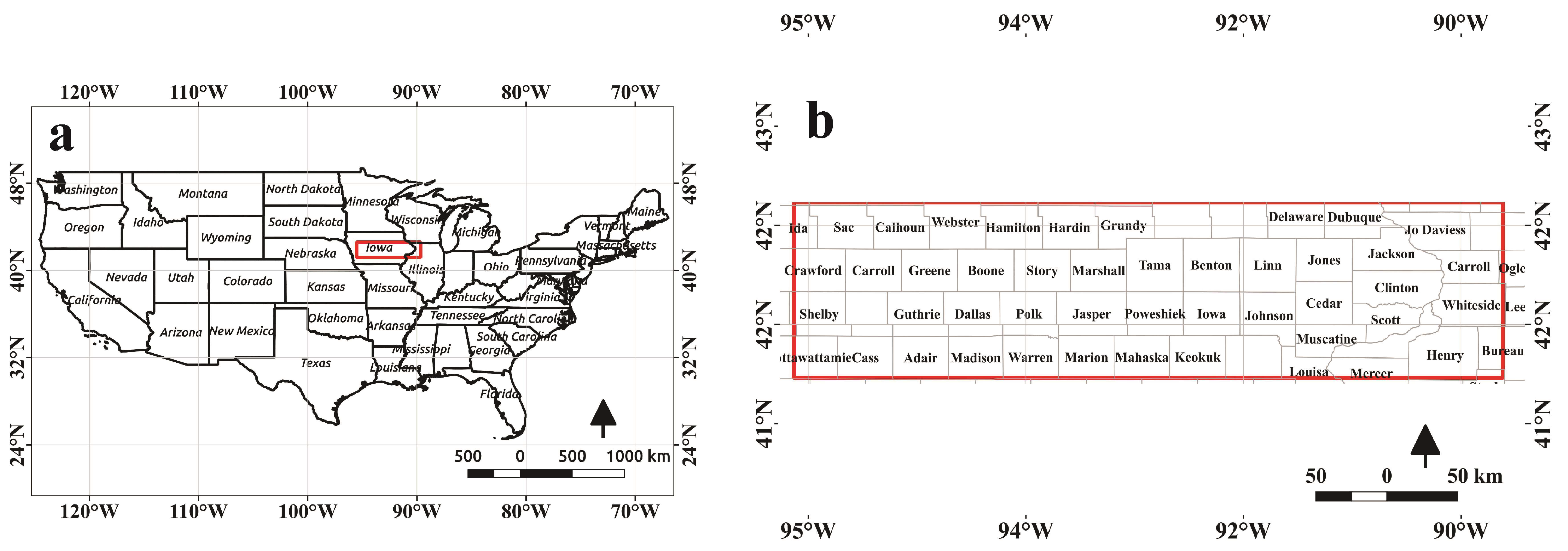
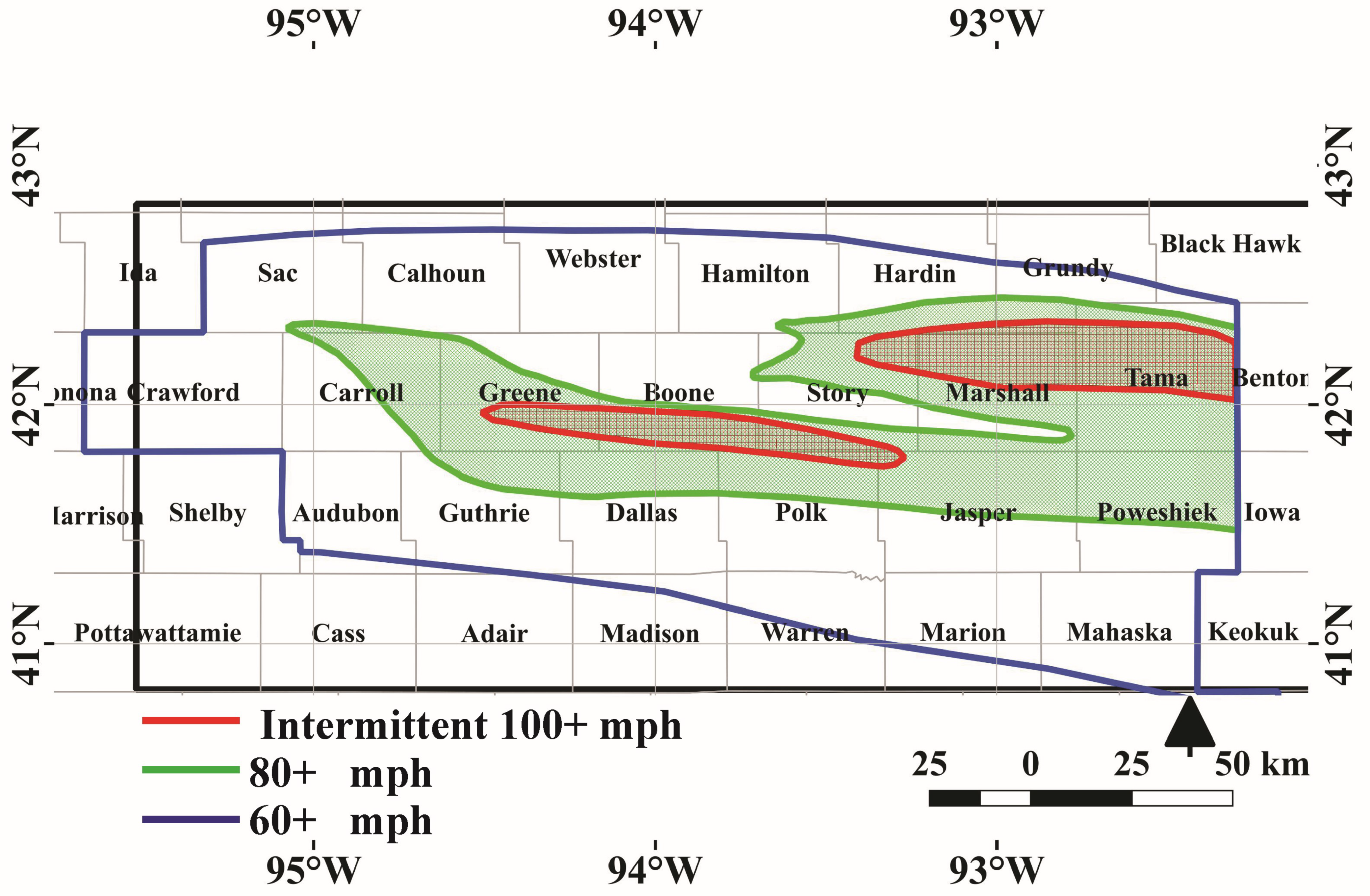
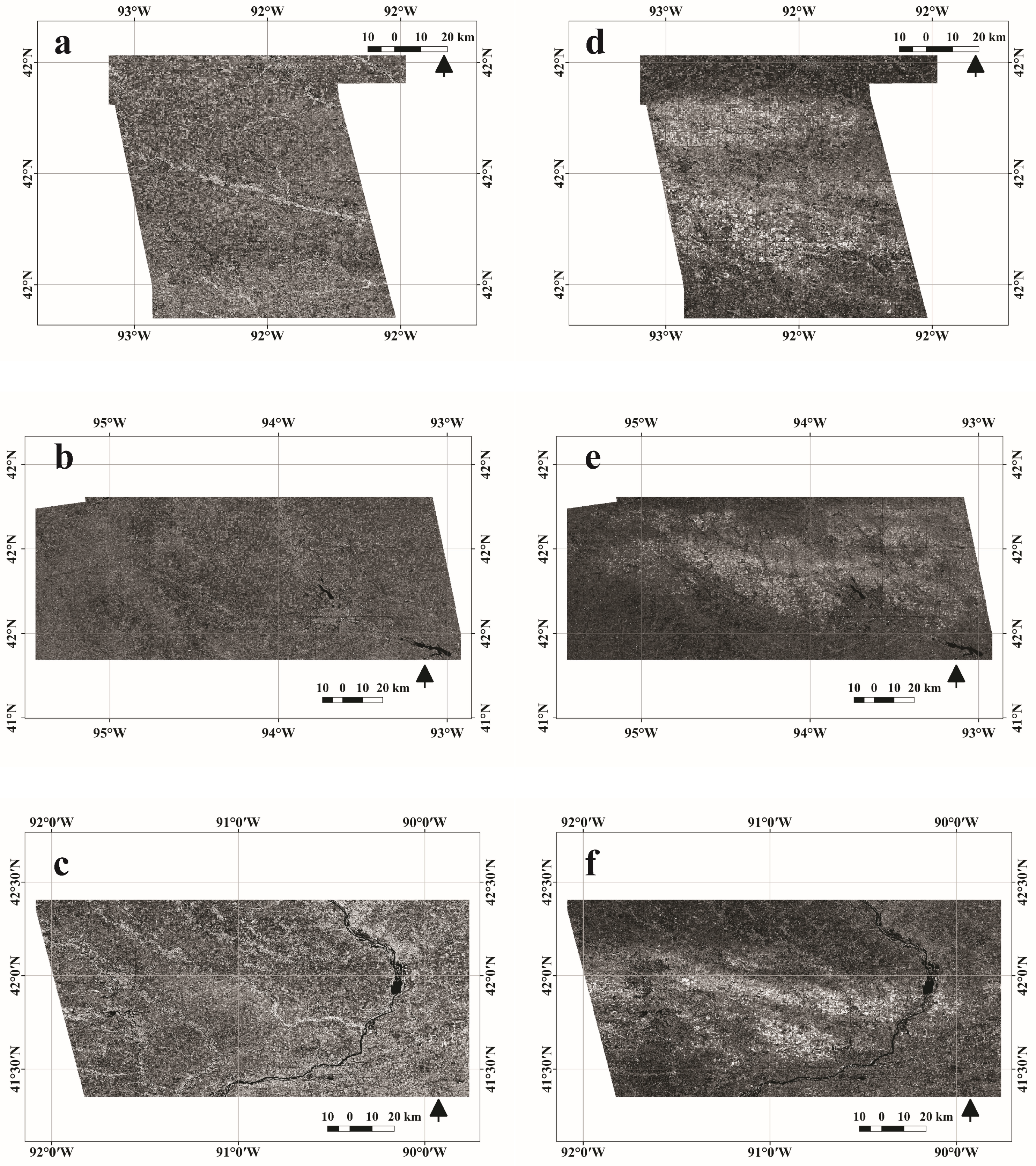

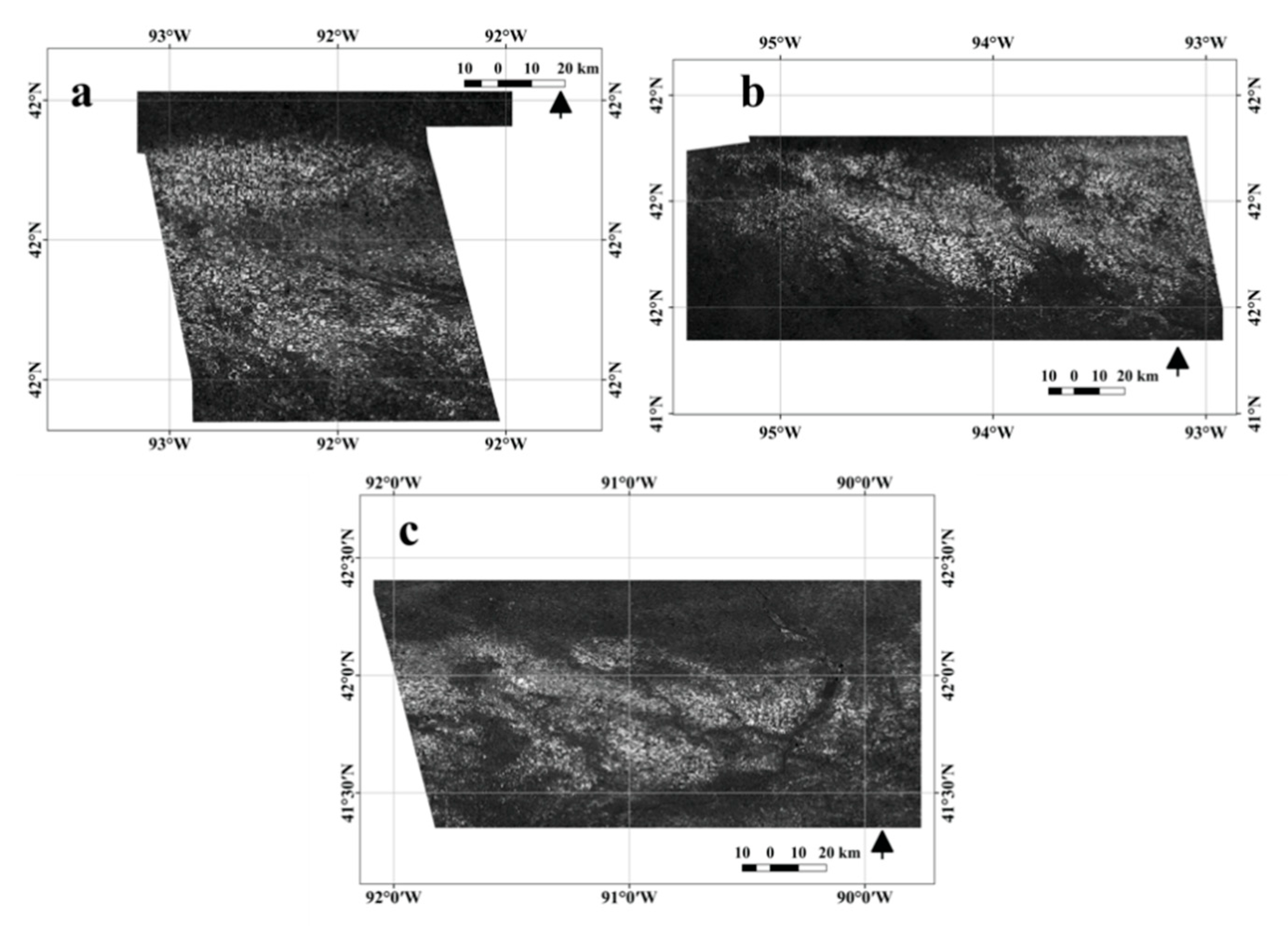
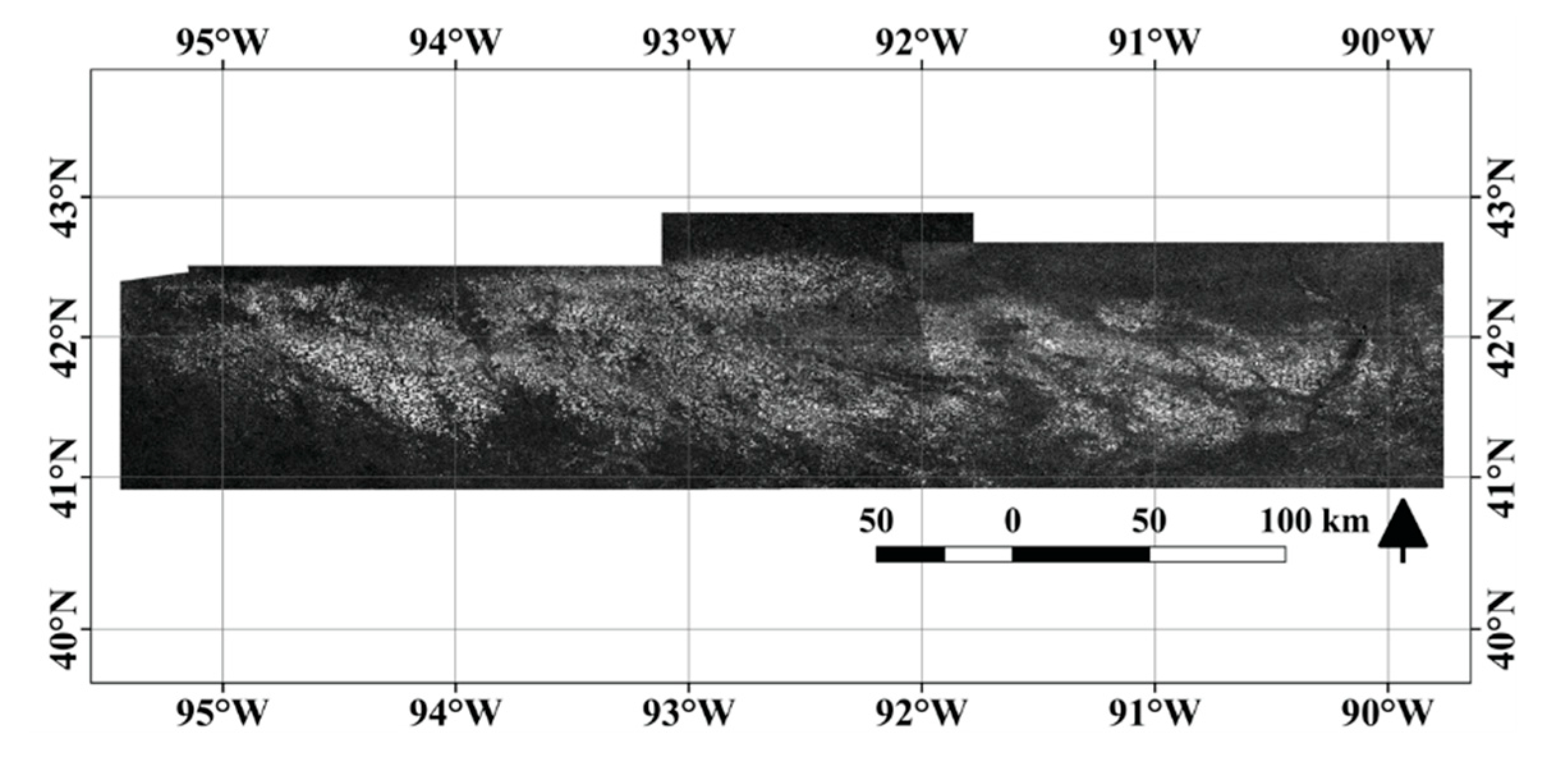


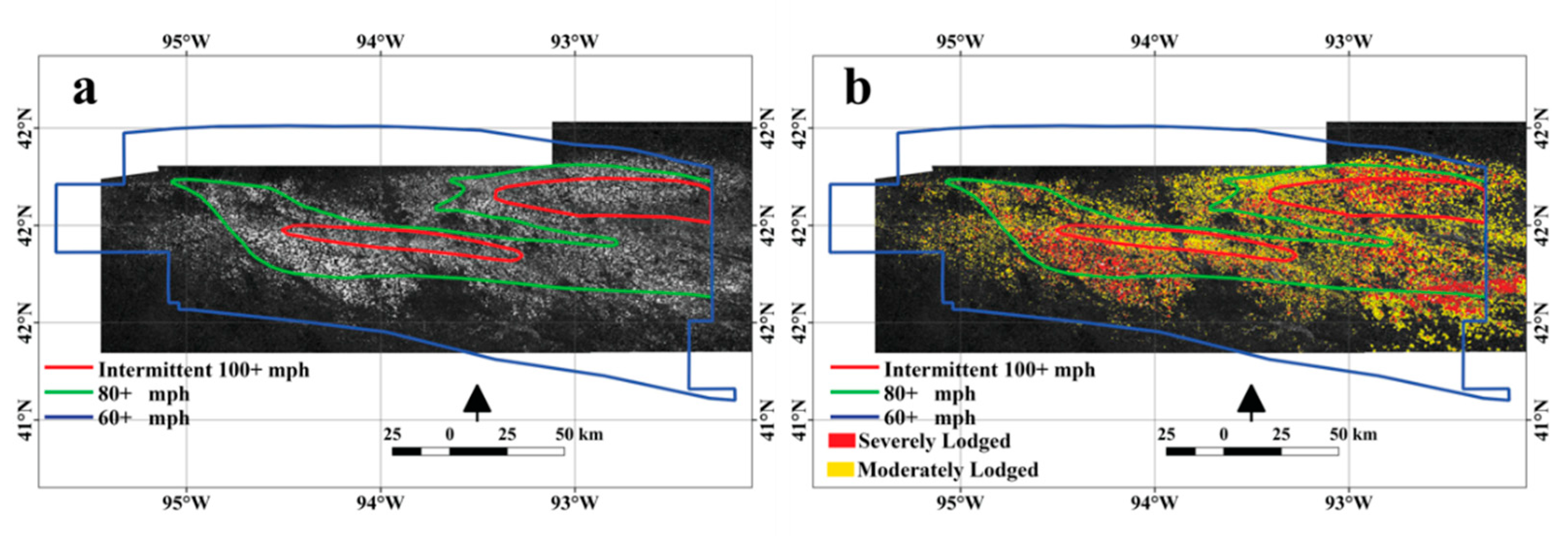
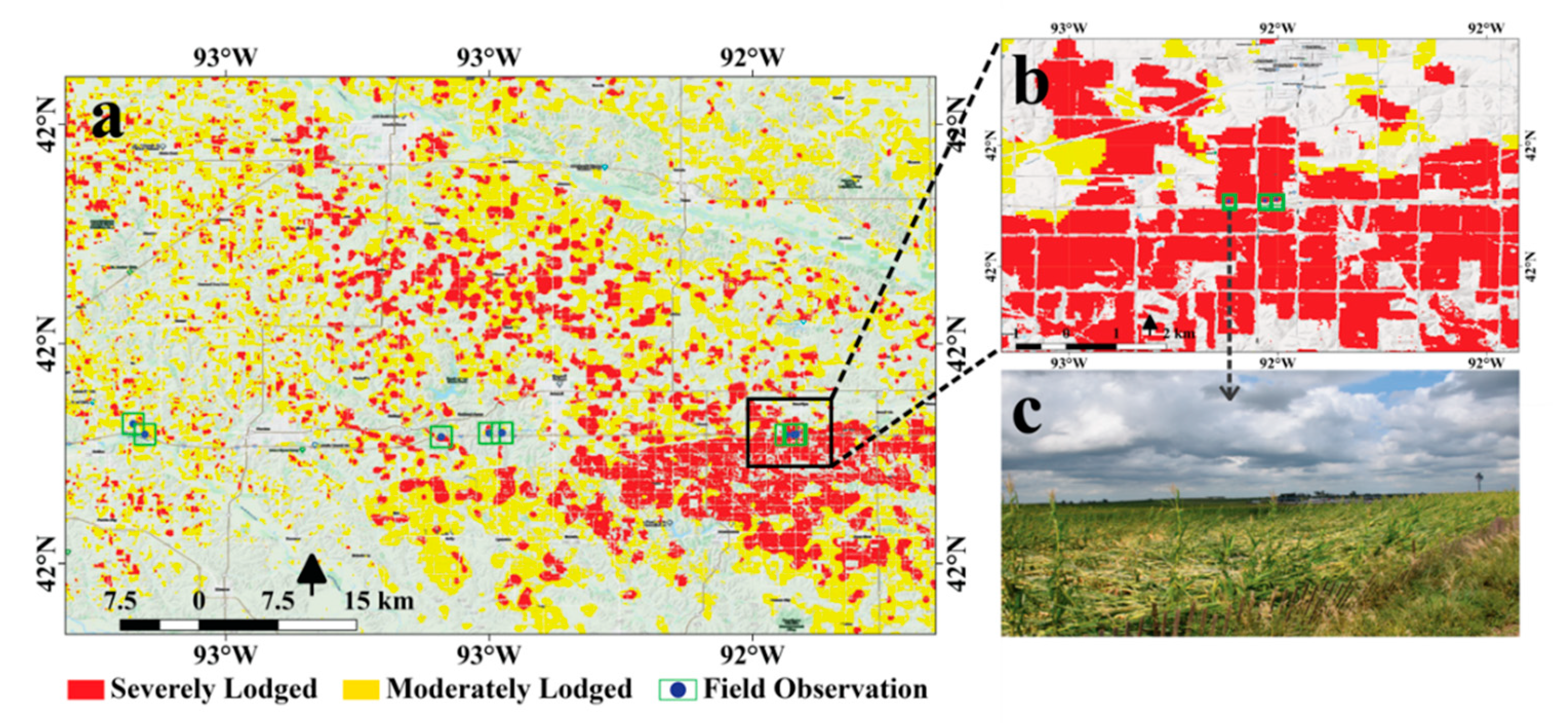

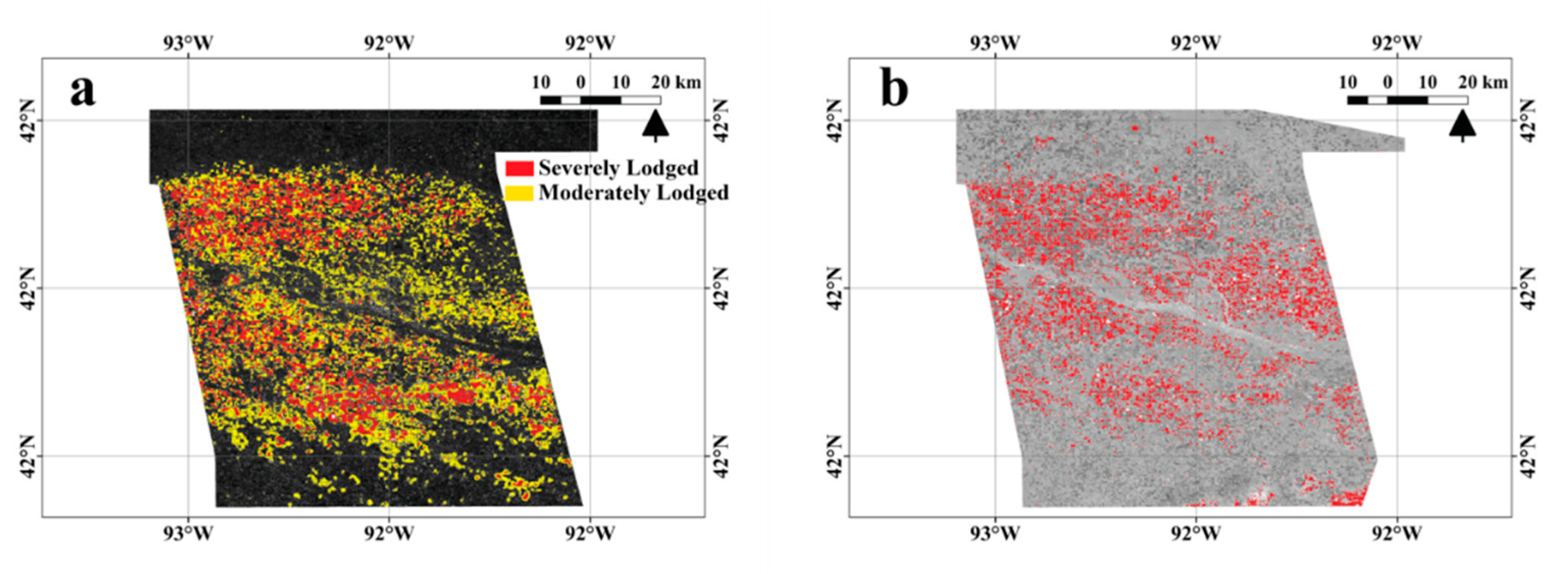
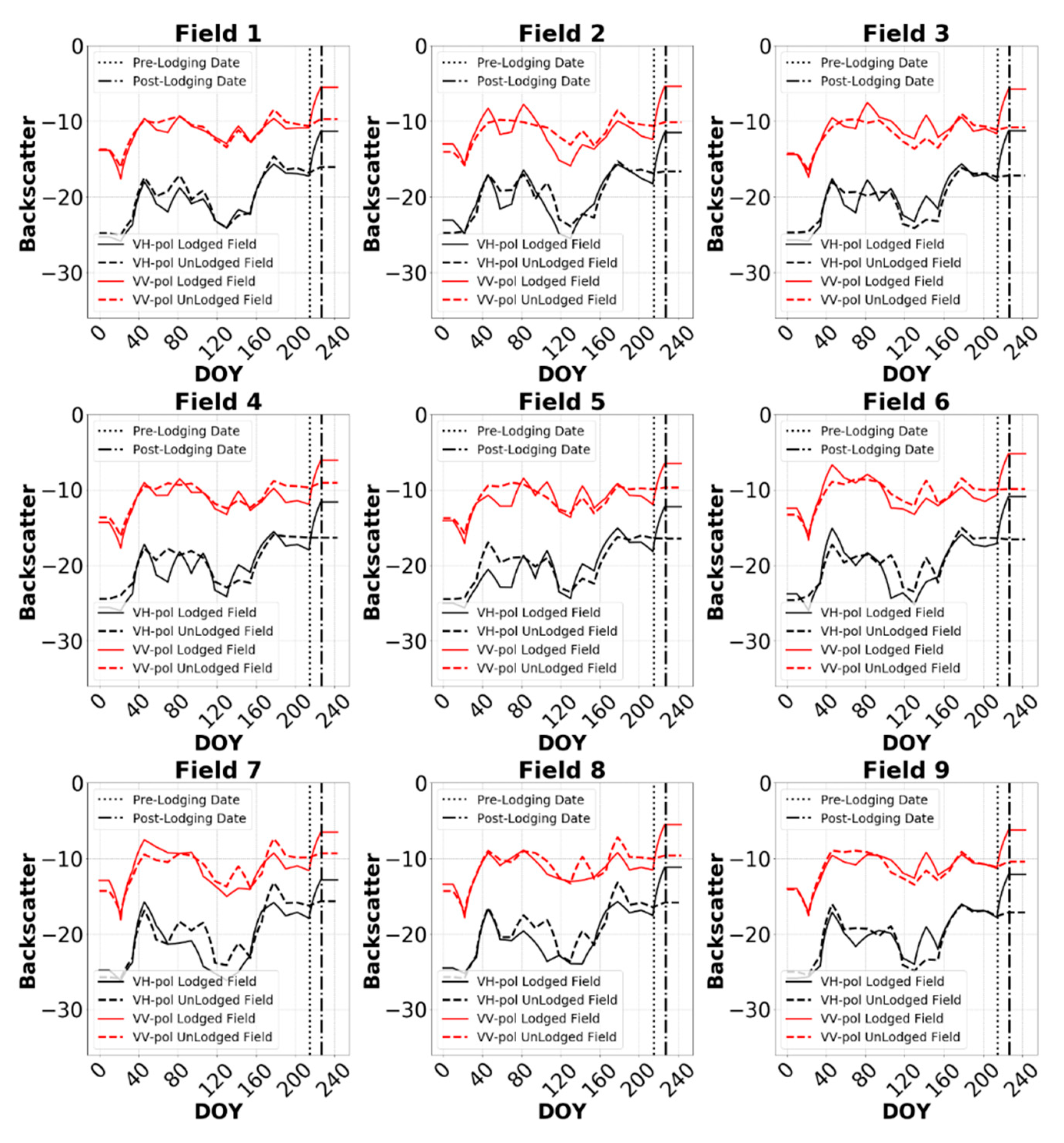
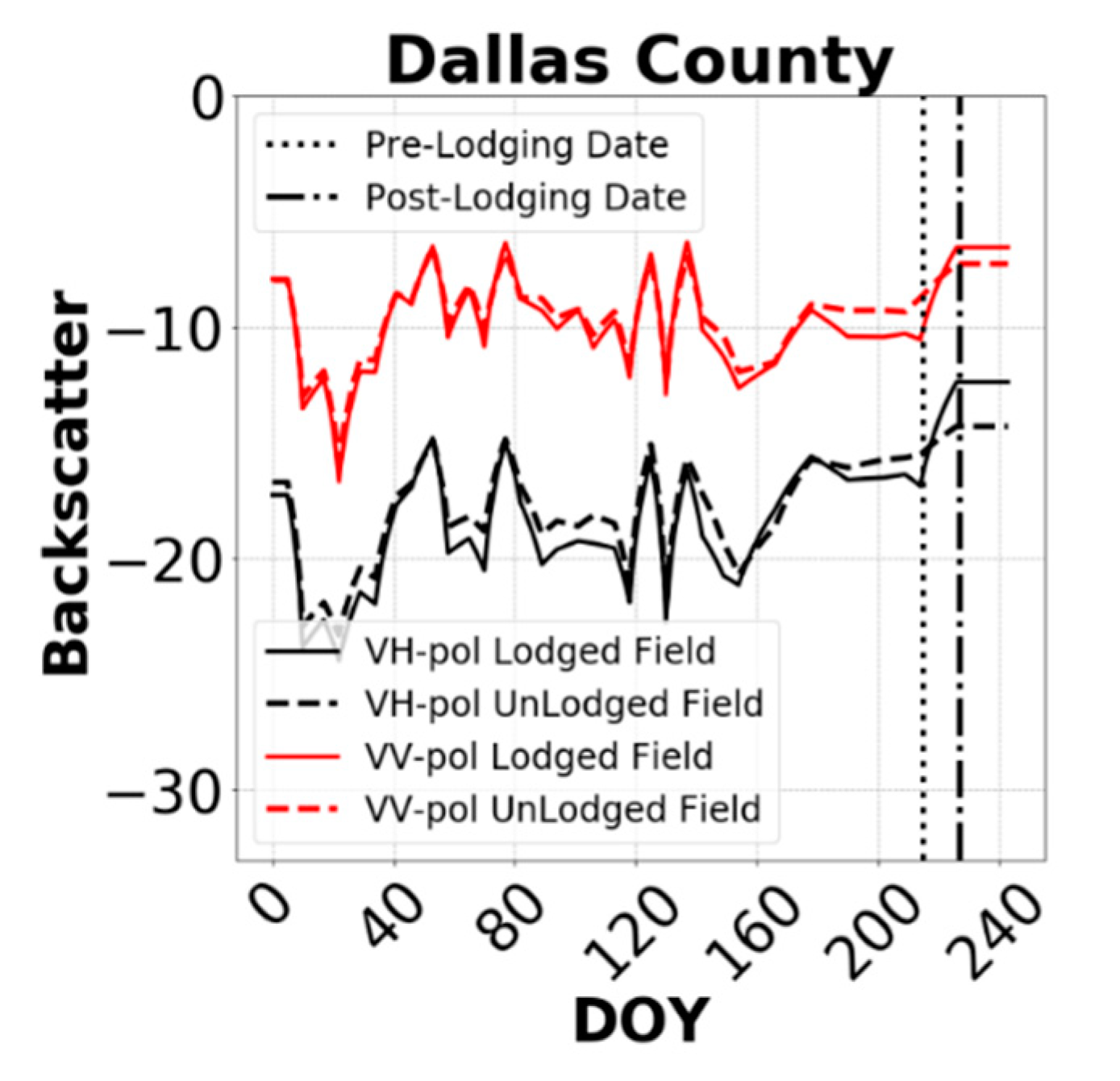
| Date 2015 | Flight Direction | Local Standard Time | Incidence Angle | Polarizations | Lodging Event |
|---|---|---|---|---|---|
| 29 July 2020 | ascending | T00:05:15.604Z | 30°–46° | VH & VV | Pre- |
| 3 August 2020 | ascending | T00:13:42.330Z | 30°–46° | VH & VV | Pre- |
| 4 August 2020 | ascending | T23:57:18.422Z | 30°–46° | VH & VV | Pre- |
| 15 August 2020 | ascending | T00:13:42.984Z | 30°–46° | VH & VV | Post- |
| 16 August 2020 | ascending | T23:57:19.120Z | 30°–46° | VH & VV | Post- |
| 22 August 2020 | ascending | T00:05:16.823Z | 30°–46° | VH & VV | Post- |
| Corn | Soybean | ||||
|---|---|---|---|---|---|
| Severe (Acres) | Moderate (Acres) | Severe (Acres) | Moderate (Acres) | Total (Acres) | |
| Figure 7a | 287,238 | 398,821 | 79,246 | 307,482 | 1,072,787 |
| Figure 7b | 466,129 | 637,524 | 121,415 | 318,600 | 1,543,668 |
| Figure 7c | 326,819 | 442,113 | 120,602 | 318,308 | 1,207,842 |
| Total (Figure 8) | 1,080,186 | 1,478,458 | 321,263 | 944,390 | |
| 2,558,644 | 1,265,653 | 3,824,297 | |||
Publisher’s Note: MDPI stays neutral with regard to jurisdictional claims in published maps and institutional affiliations. |
© 2020 by the authors. Licensee MDPI, Basel, Switzerland. This article is an open access article distributed under the terms and conditions of the Creative Commons Attribution (CC BY) license (http://creativecommons.org/licenses/by/4.0/).
Share and Cite
Ajadi, O.A.; Liao, H.; Jaacks, J.; Delos Santos, A.; Kumpatla, S.P.; Patel, R.; Swatantran, A. Landscape-Scale Crop Lodging Assessment across Iowa and Illinois Using Synthetic Aperture Radar (SAR) Images. Remote Sens. 2020, 12, 3885. https://doi.org/10.3390/rs12233885
Ajadi OA, Liao H, Jaacks J, Delos Santos A, Kumpatla SP, Patel R, Swatantran A. Landscape-Scale Crop Lodging Assessment across Iowa and Illinois Using Synthetic Aperture Radar (SAR) Images. Remote Sensing. 2020; 12(23):3885. https://doi.org/10.3390/rs12233885
Chicago/Turabian StyleAjadi, Olaniyi A., Heming Liao, Jason Jaacks, Alfredo Delos Santos, Siva P. Kumpatla, Rinkal Patel, and Anu Swatantran. 2020. "Landscape-Scale Crop Lodging Assessment across Iowa and Illinois Using Synthetic Aperture Radar (SAR) Images" Remote Sensing 12, no. 23: 3885. https://doi.org/10.3390/rs12233885
APA StyleAjadi, O. A., Liao, H., Jaacks, J., Delos Santos, A., Kumpatla, S. P., Patel, R., & Swatantran, A. (2020). Landscape-Scale Crop Lodging Assessment across Iowa and Illinois Using Synthetic Aperture Radar (SAR) Images. Remote Sensing, 12(23), 3885. https://doi.org/10.3390/rs12233885




